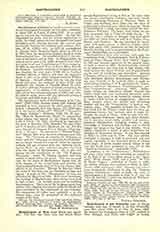

Bartholomew of Pisa, Friar Minor and chronicler. The fact that there were two Friars Minor named Bartholomew living in Pisa at the same time has caused considerable confusion, and most recent writers, following Marianus of Florence, Mark of Lisbon, and Wadding, have fallen into the error of attributing to Bartholomew Albisi the famous “Book of Conformities”, which was really written by Bartholomew Rinonico. The latter, with whom we are here concerned, was a Pisan of noble family. In 1352 he was a student at Bologna and later filled the office of Lector there as well as at Padua, Pisa, Sienna, and Florence. He also preached for many years with great success in different Italian cities. He died about 1401, renowned no less for sanctity than for learning, and is commemorated in the Franciscan Martyrology on November 4.
Bartholomew‘s chief title to fame rests upon his remarkable book, “De Conformitate Vitae B. P. Francisci ad Vitam Domini Nostri Jesu Christi”, begun in 1385 and formally approved by the general chap-ter held at Assisi in 1399. Enthusiastically received on its appearance and long held in high esteem, this work became the object of bitter and stupid attacks on the part of Lutherans and Jansenists. Against it Erasmus Alber wrote the “Alcoranus Franciscanus” (Der Barfiisser Mbnche Eulenspiegel and Alcoran mit einer Vorrede D. M. Luthers, 1531) in reply to which Henry Sedulius, O. F. M., published his “Apologeticus adversus Alcoranum Franciscanorum pro libro Conformitatum” (Antwerp, 1607). Subsequent writers on Franciscan history treated the Pisan’s work with most unmerited ostracism; more recently it has come to be lauded in certain circles in terms which savor of exaggeration. Between these extreme views, the patient and discerning student will find the “Conformities” a book of very uneven value. The parallels between the lives of Our Lord and St. Francis which form its basis are sometimes forced, but nowhere does it make St. Francis the equal of Christ. Side by side with fantastic legends, ridiculous visions, and other absurdities, it contains much really credible and precious historical information, revealing besides a deep knowledge of Scripture and theology and a critical temper not usual at the time it was written. It is rightly considered a source of great importance for students of Franciscan history. It was first printed at Milan in 1510 and in 1513. The new edition published at Bologna in 1590 is mutilated and corrupted, especially in the historical parts, at almost every page. A sorely needed critical edition of the text has lately been published in tom. IV of the “Analecta Franciscana” (Quaracchi, 1906).
In addition to the “Conformities”, Bartholomew left some thirty other works, including an exposition of the Rule of the Friars Minor found in the “Speculum” Morin (Rouen, 1509) and a book “De Vita B. Marine Virgins”, published at Venice in 1596; his Lenten sermons were printed at Milan in 1498, Venice, 1503, and Lyons, 1519. Sbaralea and others have erroneously attributed to him the “Summa Casuum Conscientiae”, which is really the work of Bartholomew a S. Concordio of Pisa, O.P., and the “Vita B. Gerardi”, which was written by Bartholomew Albisi mentioned above.
PASCHAL ROBINSON

